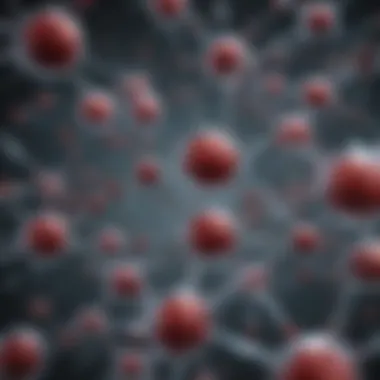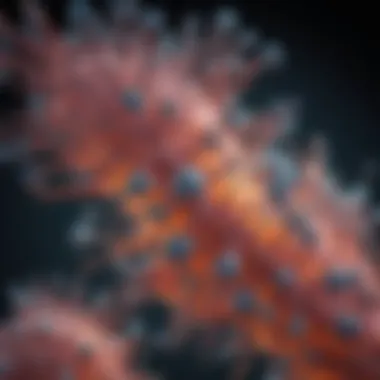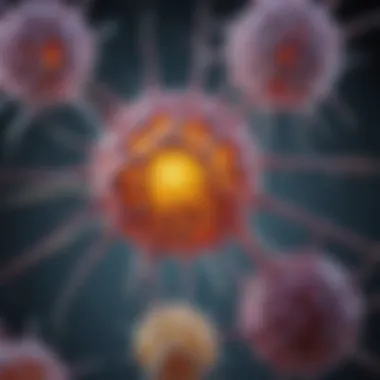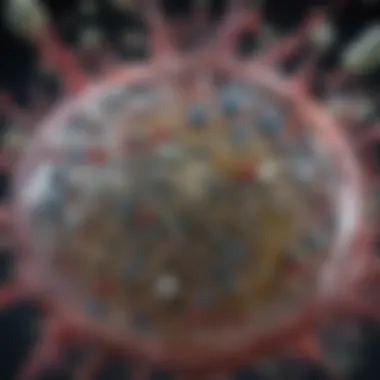Understanding KRAS G12V: Molecular Insights and Therapies


Intro
The KRAS G12V mutation is a significant factor in the realm of oncology. It plays a critical role in the context of different types of cancers, compelling researchers and healthcare professionals to deepen their understanding of its implications. This mutation may dictate the effectiveness of certain therapies, influencing treatment approaches and outcomes for patients. Accordingly, the exploration of KRAS G12V becomes essential not only for cancer biology but also for therapeutic advancements.
Research Overview
Summary of Key Findings
The KRAS G12V mutation primarily impacts cell signaling pathways. It leads to uncontrolled cell proliferation and survival, which are hallmarks of cancer. Recent studies highlight that this mutation is prevalent in various malignancies, particularly pancreatic, colorectal, and lung cancers. The insights reveal that KRAS G12V alters downstream pathways, such as the MAPK and PI3K pathways. These alterations drive tumorigenesis and present unique challenges for targeted therapies.
Background and Context
Historically, KRAS mutations were considered difficult to target therapeutically. However, the understanding of their molecular dynamics has evolved. The introduction of targeted therapies, such as sotorasib and adagrasib, has provided new hope. These agents specifically inhibit the mutated KRAS protein, aiming to disrupt its aberrant signaling. Nonetheless, resistance mechanisms pose significant challenges, making it vital to investigate the mutation's broader molecular landscape.
Methodology
Experimental Design
The research involved a combination of in vitro and in vivo analyses. These experiments aimed to elucidate the functional consequences of the KRAS G12V mutation. Key methods included cell culture assays, gene expression profiling, and pharmacological evaluations. Each of these methods contributed to a holistic understanding of the mutation's impact on cancer biology.
Data Collection Techniques
Data collected encompassed genomic sequencing, protein expression analyses, and patient outcome studies. Genomic sequencing sheds light on the mutation frequency in specific cancers. Protein expression analyses help illustrate the functional pathways affected by KRAS G12V. Furthermore, correlating patient outcomes with genetic profiles adds a critical layer of understanding the mutation's clinical relevance.
"The KRAS G12V mutation is not just a genetic alteration; it is a beacon for potential therapeutic strategies that could revolutionize cancer treatment."
Preamble to KRAS G12V
Understanding the KRAS G12V mutation is critical in the field of cancer research. This mutation is not merely an epiphenomenon; it plays a significant role in the progression of various malignancies, including pancreatic, lung, and colorectal cancers. The implications of KRAS G12V are profound, affecting cellular signaling pathways that drive uncontrolled cell growth and proliferation.
The article elucidates the biological and clinical importance of the KRAS G12V mutation. By exploring its molecular mechanisms, one can gain insights into how this mutation alters normal cellular functions and contributes to oncogenesis. Additionally, understanding KRAS G12V helps in the development of therapeutic strategies aimed at targeting this specific mutation, thus opening avenues for more effective cancer treatments.
Definition of KRAS and its Family
KRAS is an essential gene that encodes a protein functioning as a molecular switch in cell signaling pathways. It is part of the RAS family, which includes HRAS and NRAS. These proteins regulate a variety of cellular processes, including growth, differentiation, and apoptosis. When functioning correctly, KRAS is activated by signaling molecules such as growth factors. This activation is transient and properly regulated under normal physiological conditions.
However, mutations in the KRAS gene can disrupt its function, leading to persistent activation. The G12V mutation occurs at the glycine-12 position, where the amino acid is replaced by valine. This alteration has significant consequences on KRAS's ability to hydrolyze GTP, effectively locking the protein in its active form and continually signaling for cell growth and division.
Significance of the G12V Mutation
The G12V mutation holds a particular significance within the KRAS family due to its high prevalence in numerous cancers. Approximately 30% of all human cancers are attributed to mutations in the KRAS gene, with G12V being among the most commonly observed variants. Its significance lies not only in how it skews normal signaling pathways but also in how it aids cancer cells in evading standard therapeutic approaches.
Given its role in tumor biology, understanding the implications of the G12V mutation is essential for developing targeted therapies. For example, the mutation can lead to distinct tumor behaviors and responses to treatment regimens, necessitating tailored strategies to improve patient outcomes. The presence of KRAS G12V in a tumor can influence prognosis and guide clinical decision-making. Consequently, research into KRAS G12V is imperative for advancing cancer management and treatment protocols.
Biological Role of KRAS
The biological role of KRAS is central to understanding its function in cancer biology and the clinical implications of the G12V mutation. KRAS is a member of the RAS gene family, which encodes proteins involved in various signaling pathways that regulate cell growth, differentiation, and survival. The importance of KRAS lies in its status as a key signaling molecule in these pathways, particularly the MAPK/ERK and PI3K/AKT pathways. This section will examine these signaling pathways in detail, showing how alterations in KRAS can influence cellular behavior and contribute to oncogenesis.
Overview of RAS Signaling Pathways


RAS proteins act as molecular switches. In their active form, they bind to GTP and associate with downstream signaling partners, influencing numerous cellular processes. The primary pathways affected by RAS activation include:
- MAPK/ERK Pathway: This pathway is vital for cell proliferation and differentiation. Activated KRAS interacts with RAF kinase, initiating a cascade that leads to the activation of MEK and ERK, ultimately promoting gene expression related to cell division.
- PI3K/AKT Pathway: This pathway is crucial for cell survival and metabolism. When KRAS is activated, it associates with PI3K, leading to the production of PIP3. This lipid molecule activates AKT, allowing the cell to survive and grow.
Understanding the dynamics of these pathways is essential for grasping how mutations in KRAS, like G12V, can lead to malignancy. When KRAS is mutated, its binding to GTP occurs more frequently, leading to constant activation of these pathways, resulting in uncontrolled cell growth and proliferation.
Functions in Cell Growth and Differentiation
The functions of KRAS in regulating cell growth and differentiation are multifaceted. KRAS plays a pivotal role in various cellular processes:
- Cell Proliferation: KRAS directly influences cell cycle progression. Mutated KRAS, such as the G12V variant, can accelerate cell division, contributing to tumor development.
- Apoptosis Regulation: KRAS also affects mechanisms of programmed cell death. The persistent activation of pathways via KRAS mutants can interfere with the normal apoptotic signals, allowing cancer cells to evade death.
- Metabolic Changes: KRAS contributes to cellular metabolism. It regulates pathways that increase nutrient uptake and fermentation, which provides energy for rapidly proliferating cancer cells.
- Differentiation: Normal KRAS function allows cells to develop into distinct cell types. Mutated KRAS can disrupt this process, leading to less differentiated, more aggressive tumor phenotypes.
In a clinical context, recognizing the biological role of KRAS can inform treatment strategies. Targeting the signaling pathways altered by KRAS mutations can reveal potential therapeutic approaches. Understanding how KRAS G12V interacts with various cellular mechanisms aids in the design of targeted therapies that may block its action or mitigate its effects.
"KRAS mutations are common in many type of cancers, and understanding their role is crucial for designing effective therapies."
In summary, the biological role of KRAS is intricate and profoundly impacts understanding cancer's molecular underpinnings. The following sections will explore the impacting mechanisms further, especially focusing on transformation and epidemiology.
Mechanism of KRAS G12V-induced Transformation
The KRAS G12V mutation plays a critical role in the transformation of normal cells into cancerous cells. Understanding the mechanisms involved is essential for developing effective therapies. This transformation is driven by specific changes in protein function and alterations in cellular signaling pathways. Exploring these elements leads to a clearer picture of how KRAS G12V contributes to oncogenesis.
Mutation Consequences on Protein Function
The G12V mutation leads to a substitution in the KRAS protein, where glycine (G) is replaced by valine (V) at position 12. This alteration impacts the protein's activity significantly. The mutation causes KRAS to adopt a constitutively active state. In this state, it remains continuously activated, leading to unrestrained signaling through various pathways that promote cell proliferation and survival.
Furthermore, the G12V mutation diminishes the protein's ability to hydrolyze GTP, prolonging the signaling duration. This sustained activation of KRAS leads to enhanced cell growth and survival, common characteristics of cancer cells. The direct consequence of G12V is an amplified cellular environment that favors malignancy.
Impact on Cellular Pathways
MAPK/ERK Pathway
The MAPK/ERK pathway is a major downstream signaling pathway activated by KRAS. This pathway regulates vital cellular processes such as proliferation, differentiation, and survival. In the presence of the KRAS G12V mutation, the pathway is frequently overactive. This allows cancer cells to grow unchecked. A key characteristic of the MAPK/ERK pathway is its ability to convert extracellular signals into appropriate cellular responses.
Ultimately, this pathway's overactivation is a significant contributor to oncogenic transformation. It provides critical insights into how cancer progresses, making it a focal point for therapeutic targeting. The unique attribute of this pathway is its branching nature, linking various signaling components, such as RAF and MEK.
While targeting the MAPK/ERK pathway shows promise, it also presents challenges. Cancer cells may develop resistance to therapies aimed at this pathway. Therefore, a nuanced understanding of its role in KRAS G12V transformation is crucial.
PI3K/AKT Pathway
The PI3K/AKT pathway is another vital signaling cascade influenced by KRAS G12V. Activation of this pathway promotes cellular survival and growth. It is particularly relevant in cancer biology due to its role in protecting cells from apoptosis. A significant feature of the PI3K/AKT pathway is its interaction with growth factors. These interactions lead to a series of downstream effects that allow cells to thrive even under adverse conditions.
The PI3K/AKT pathway is essential for understanding KRAS G12V's role in tumor maintenance and progression. Its activation promotes metabolic changes that favor cancer cell survival. However, like the MAPK/ERK pathway, this pathway also faces the challenge of resistance mechanisms, which can limit the effectiveness of targeted therapies.
In summary, the mechanisms by which KRAS G12V induces transformation lie in its impact on critical cellular pathways. The understanding of both the MAPK/ERK and PI3K/AKT pathways provides insights into potential therapeutic strategies needed to combat cancers associated with this mutation.
Epidemiology of KRAS G12V in Cancer
The epidemiology of the KRAS G12V mutation holds significant relevance in cancer research. Understanding its prevalence and association with various cancer types provides insights that can shape therapeutic strategies. Notably, identifying the frequency of KRAS G12V helps in risk assessment and targeting specific populations that may benefit from emerging therapies. By studying its distribution across different cancers, researchers can better comprehend the mutational landscape, leading to improved patient outcomes.


Prevalence in Solid Tumors
KRAS mutations, specifically G12V, are commonly found in solid tumors. Studies indicate that about 25% to 30% of colon cancers and approximately 90% of pancreatic cancers harbor a KRAS mutation. The presence of G12V specifically varies among tumor types. Its prevalence makes KRAS G12V a focal point for targeted therapy development. Understanding how widespread KRAS G12V is offers crucial insights into the molecular basis of tumorigenesis.
Association with Specific Cancer Types
Pancreatic Cancer
Pancreatic cancer's relationship with KRAS G12V is one of the most studied aspects of this mutation. Approximately 90% of pancreatic adenocarcinomas display KRAS mutations, with G12V being a prominent variant. The high association underscores its potential role as a therapeutic target. This characteristic serves as a crucial point of interest for researchers aiming to develop specific inhibitors that can effectively disrupt the function of mutated KRAS. However, the aggressive nature of pancreatic cancer poses challenges in early detection and treatment, complicating efforts to target KRAS effectively.
Lung Cancer
In non-small cell lung cancer, KRAS G12V is also a critical player. About 25% of lung adenocarcinomas present with KRAS mutations, where G12V accounts for a significant portion. The complexity of lung cancer highlights the unique challenges posed by its heterogeneity. Targeting KRAS in lung cancer may lead to breakthroughs in treatment, but the diverse nature of lung tumors requires personalized approaches. Understanding G12V's role in this context can direct future research in developing more effective therapies.
Colorectal Cancer
Colorectal cancer presents another arena where KRAS G12V plays a role. Nearly 40% of colorectal cancers feature some form of KRAS mutation, with G12V as a common variant. This mutation not only helps identify patients who may benefit from specific treatments but also informs the prognosis of the disease. Advanced understanding of KRAS G12V in this cancer type aids in stratifying patients, leading to more tailored therapeutic approaches. However, the rise of resistance mechanisms presents challenges in treating colorectal cancer with KRAS mutations effectively.
Understanding the prevalence and association of KRAS G12V with specific cancers is essential in the effort to tailor effective treatments.
Challenges in Targeting KRAS G12V
The mutation KRAS G12V presents significant challenges in cancer therapy. Understanding these challenges is vital for developing effective treatment strategies. The G12V mutation plays a central role in cancer biology, making its targeting crucial but complex. It is characterized by alterations that complicate traditional approaches, rendering many therapies less effective.
Intrinsic Resistance Mechanisms
Intrinsic resistance refers to the mechanisms within cancer cells that allow them to evade the effects of therapies. In the case of KRAS G12V, several pathways contribute to this phenomenon.
- Activation of Alternative Pathways: Cancer cells often activate alternative signaling pathways like the PI3K/AKT route. These pathways can compensate for blocked signals in the RAS pathway.
- Enhancement of Drug Efflux: Some cells increase the expression of transporters that pump out drugs, leading to decreased overall drug availability. This effort limits the efficacy of treatments designed to target KRAS functions directly.
- Metabolic Reprogramming: KRAS G12V mutations drive metabolic changes that favor cell survival, further complicating treatment strategies. Cells may shift to reliance on glycolysis instead of oxidative phosphorylation, creating environments where traditional therapies struggle to succeed.
Overall, intrinsic resistance mechanisms make it challenging to effectively target KRAS G12V and require novel therapeutic approaches that can circumvent these adaptations.
Molecular Heterogeneity in Tumors
Molecular heterogeneity in tumors adds another layer of difficulty in targeting KRAS G12V effectively. Tumors are not uniform; they contain a diverse population of cells, each with different mutations and characteristics. This diversity can lead to varying responses to treatment among tumor cell populations.
- Clonal Evolution: KRAS G12V can coexist with other mutations within individual tumors. This clonal evolution allows subpopulations to survive therapy, leading to cancer progression despite initial treatment responses.
- Variability in Drug Response: The heterogeneity means that not all cells within a tumor react the same way to targeted therapies. Some cells may have additional mutations that confer resistance to specific drugs, necessitating a more tailored approach to therapy.
- Implications for Biomarker Development: The presence of mixed populations complicates the identification of reliable biomarkers. Biomarkers are essential for predicting responses to treatment and for patient selection in clinical trials.
The challenges presented by molecular heterogeneity require innovative strategies in therapy design and patient management to ensure that all tumor cell types receive adequate treatment.
"Addressing the challenges in targeting KRAS G12V will be crucial for improving patient outcomes in cancer treatment."
In summary, intrinsic resistance mechanisms and molecular heterogeneity in tumors significantly affect the success of KRAS G12V-targeted therapies. A deeper understanding of these challenges is crucial for researchers and clinicians focused on cancer treatment advancements.
Current and Emerging Therapies for KRAS G12V
The landscape of cancer treatment is evolving rapidly, especially with the emergence of personalized medicine. In the context of KRAS G12V, therapies specifically targeting this mutation have gained significant attention. Given the particular role of KRAS G12V in tumorigenesis, focusing on therapies tailored for this mutation is crucial. These therapies aim to improve outcomes for patients whose cancers exhibit this specific genetic alteration, offering a more effective alternative to traditional approaches.
Small Molecule Inhibitors


Small molecule inhibitors represent a cornerstone of modern oncology therapeutics, particularly for addressing KRAS G12V mutations. These agents work by directly targeting KRAS or its downstream signaling pathways to inhibit their activity. Recent developments have led to several promising inhibitors such as Sotorasib (Lumakras) and Adagrasib. These drugs have shown the potential to reduce tumor growth in preclinical models and early-phase clinical trials.
The main advantage of small molecule inhibitors is their ability to achieve selective targeting of mutant KRAS G12V, sparing normal cells and tissues from collateral damage. This selectivity helps potentially minimize side effects, which is often a concern with broader oncologic therapies. However, resistance to these inhibitors is a challenge that researchers continue to explore, necessitating ongoing trials and investigations to fully understand their efficacy in diverse patient populations.
Combination Therapies
Combination therapies for KRAS G12V hold promise in overcoming intrinsic resistance seen with single-agent therapies. By integrating small molecule inhibitors with other therapeutic modalities, such as chemotherapy, immunotherapy, or targeted agents, a more robust treatment strategy can be developed.
One compelling approach is combining KRAS inhibitors with agents that target the MAPK/ERK pathway or the PI3K/AKT pathway. This dual targeting can help address the pathways that cancer cells may activate when faced with treatment. Recent studies have indicated that such combinations can lead to enhanced antitumor activity, suggesting a synergistic effect that could improve patient prognosis.
"Combining therapies may lead to a more profound impact on tumor regression, overcoming the challenges posed by resistance mechanisms."
Ultimately, the development of both small molecule inhibitors and combination therapies for KRAS G12V is vital for creating tailored treatment regimens. These emerging options represent a significant advance in the management of KRAS G12V-driven cancers and hold the potential to improve survival rates and quality of life for patients.
Clinical Considerations and Future Directions
Understanding the clinical considerations related to KRAS G12V mutation is crucial for effective management of patients with cancers driven by this alteration. This section explores how specific elements such as patient selection, biomarkers, and ongoing research influence therapeutic strategies for these individuals. A well-rounded appreciation for these factors is essential for advancing treatment outcomes.
Patient Selection and Biomarkers
Patient selection plays a pivotal role in tailoring treatment plans for those with KRAS G12V mutations. Identifying the right patients who are most likely to respond to specific therapies enhances the efficacy of treatment.
Biomarkers, which are measurable indicators of the biological state, help guide this selection. They can predict response to therapies or offer insights into the progression of the disease. For KRAS G12V, commonly evaluated biomarkers include:
- KRAS mutation status: Determining if a patient has the G12V mutation is critical as it significantly influences treatment decisions.
- Co-occurring mutations: Analyzing other mutations present in the tumor can provide insights into potential resistance mechanisms.
- Tumor microenvironment: The characteristics of the tumor's microenvironment may influence the efficacy of targeted therapies.
Understanding how these biomarkers correlate with patient outcomes helps clinicians make informed decisions.
Ongoing Clinical Trials
Ongoing clinical trials are essential for expanding the knowledge regarding KRAS G12V and finding new therapeutic avenues. Currently, numerous trials focus on different aspects of treatment, ranging from novel targeted therapies to combination regimens.
Key areas of exploration in these trials include:
- Targeted inhibitors: Several trials investigate the efficacy of small molecule inhibitors specifically designed to target the KRAS G12V mutation, aiming to overcome the challenges previously faced in KRAS-targeted therapies.
- Immunotherapies: Research is focusing on combining immunotherapy with KRAS-targeted agents to improve patient outcomes, particularly in patients with advanced disease.
- Combination therapies: Many trials are exploring various combinations of chemotherapy and targeted agents to enhance treatment effects while mitigating resistance.
Identifying successful treatment approaches through clinical trials will provide essential data to refine future guidelines for managing KRAS G12V-associated cancers.
End
The exploration of KRAS G12V is crucial for understanding its role in cancer biology. This mutation is not just a statistical anomaly; it significantly alters cellular behavior and has profound implications for patient management. Understanding the complexities of KRAS G12V helps healthcare professionals make informed choices about treatment plans. Researchers can better focus their efforts on specific biological pathways that are disrupted by the G12V mutation.
Summary of Key Findings
The key findings from this article reveal several important points about KRAS G12V:
- Molecular Mechanism: KRAS G12V activates signaling pathways critical for tumor growth and survival, particularly the MAPK and PI3K/AKT pathways.
- Clinical Relevance: The mutation is prevalent in several cancers, including pancreatic, lung, and colorectal cancers. Its presence often correlates with a poorer prognosis and may dictate the choice of therapeutic strategies.
- Challenges: Targeting KRAS G12V presents unique challenges; intrinsic resistance and molecular heterogeneity in tumors complicate treatment efforts. Efforts to develop small molecule inhibitors are ongoing but meet difficulties in achieving high specificity.
These findings underscore the significance of KRAS G12V not only as a molecule of interest but also as a critical factor in the therapeutic landscape of oncology.
The Future of KRAS G12V Research
The future of KRAS G12V research appears promising yet challenging. Ongoing clinical trials aim to innovate ways to target this mutation more effectively. Furthermore, the identification of specific biomarkers could aid in the selection of patients who are most likely to benefit from targeted therapies.
Additionally, understanding the tumor microenvironment's role in KRAS-driven oncology may provide new insights. By integrating genetic information with advanced molecular techniques, researchers could decode the intricate web of interactions facilitated by KRAS G12V.
In summary, as new treatments and understanding emerge, continual research into KRAS G12V will be essential for improving outcomes for patients with cancers bearing this mutation.







